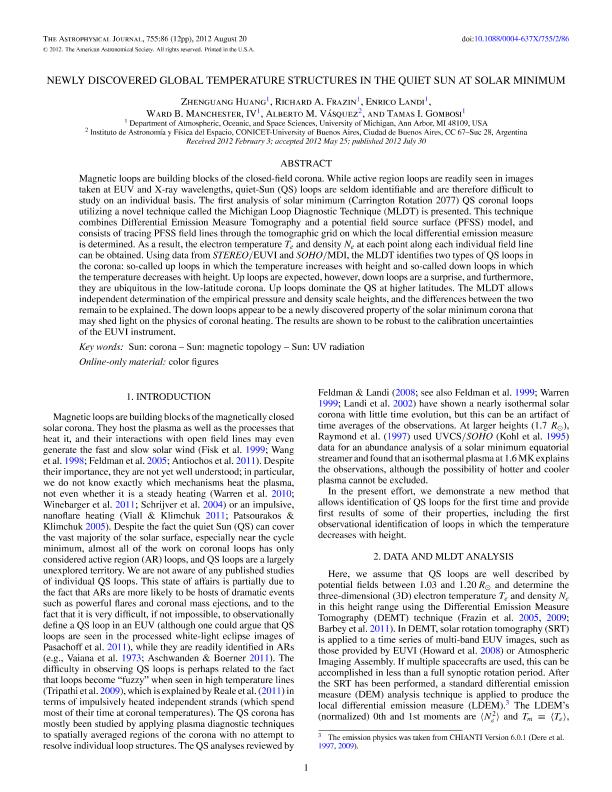Mostrar el registro sencillo del ítem
dc.contributor.author
Huang, Zhenguang
dc.contributor.author
Frazin, Richard A.
dc.contributor.author
Landi, Enrico
dc.contributor.author
Manchester, Ward B.
dc.contributor.author
Vasquez, Alberto Marcos

dc.contributor.author
Gombosi, Tamas I.
dc.date.available
2019-05-21T14:56:10Z
dc.date.issued
2012-08
dc.identifier.citation
Huang, Zhenguang; Frazin, Richard A.; Landi, Enrico; Manchester, Ward B.; Vasquez, Alberto Marcos; et al.; Newly discovered global temperature structures in the quiet sun at solar minimum; IOP Publishing; Astrophysical Journal; 755; 2; 8-2012; 86-98
dc.identifier.issn
0004-637X
dc.identifier.uri
http://hdl.handle.net/11336/76785
dc.description.abstract
Magnetic loops are building blocks of the closed-field corona. While active region loops are readily seen in images taken at EUV and X-ray wavelengths, quiet-Sun (QS) loops are seldom identifiable and are therefore difficult to study on an individual basis. The first analysis of solar minimum (Carrington Rotation 2077) QS coronal loops utilizing a novel technique called the Michigan Loop Diagnostic Technique (MLDT) is presented. This technique combines Differential Emission Measure Tomography and a potential field source surface (PFSS) model, and consists of tracing PFSS field lines through the tomographic grid on which the local differential emission measure is determined. As a result, the electron temperature Te and density Ne at each point along each individual field line can be obtained. Using data from STEREO/EUVI and SOHO/MDI, the MLDT identifies two types of QS loops in the corona: so-called up loops in which the temperature increases with height and so-called down loops in which the temperature decreases with height. Up loops are expected, however, down loops are a surprise, and furthermore, they are ubiquitous in the low-latitude corona. Up loops dominate the QS at higher latitudes. The MLDT allows independent determination of the empirical pressure and density scale heights, and the differences between the two remain to be explained. The down loops appear to be a newly discovered property of the solar minimum corona that may shed light on the physics of coronal heating. The results are shown to be robust to the calibration uncertainties of the EUVI instrument. © © 2012. The American Astronomical Society. All rights reserved..
dc.format
application/pdf
dc.language.iso
eng
dc.publisher
IOP Publishing

dc.rights
info:eu-repo/semantics/openAccess
dc.rights.uri
https://creativecommons.org/licenses/by-nc-sa/2.5/ar/
dc.subject
Sun: Corona
dc.subject
Sun: Magnetic Topology
dc.subject
Sun: Uv Radiation
dc.subject.classification
Astronomía

dc.subject.classification
Ciencias Físicas

dc.subject.classification
CIENCIAS NATURALES Y EXACTAS

dc.title
Newly discovered global temperature structures in the quiet sun at solar minimum
dc.type
info:eu-repo/semantics/article
dc.type
info:ar-repo/semantics/artículo
dc.type
info:eu-repo/semantics/publishedVersion
dc.date.updated
2019-05-14T21:19:57Z
dc.journal.volume
755
dc.journal.number
2
dc.journal.pagination
86-98
dc.journal.pais
Reino Unido

dc.journal.ciudad
Londres
dc.description.fil
Fil: Huang, Zhenguang. University Of Michigan, Ann Arbor; Estados Unidos
dc.description.fil
Fil: Frazin, Richard A.. University Of Michigan, Ann Arbor; Estados Unidos
dc.description.fil
Fil: Landi, Enrico. University Of Michigan, Ann Arbor; Estados Unidos
dc.description.fil
Fil: Manchester, Ward B.. University Of Michigan, Ann Arbor; Estados Unidos
dc.description.fil
Fil: Vasquez, Alberto Marcos. Consejo Nacional de Investigaciónes Científicas y Técnicas. Oficina de Coordinación Administrativa Ciudad Universitaria. Instituto de Astronomía y Física del Espacio. - Universidad de Buenos Aires. Facultad de Ciencias Exactas y Naturales. Instituto de Astronomía y Física del Espacio; Argentina
dc.description.fil
Fil: Gombosi, Tamas I.. University Of Michigan, Ann Arbor; Estados Unidos
dc.journal.title
Astrophysical Journal

dc.relation.alternativeid
info:eu-repo/semantics/altIdentifier/doi/http://dx.doi.org/10.1088/0004-637X/755/2/86
Archivos asociados
